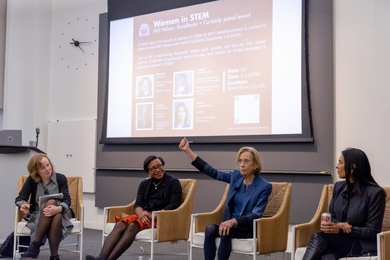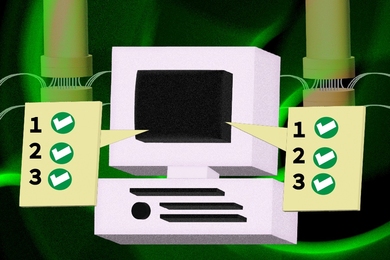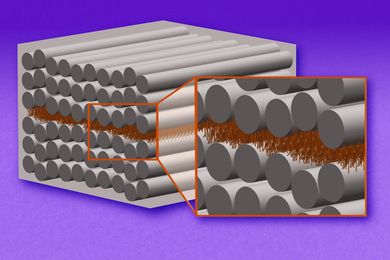Each of the brain’s 100 billion neurons forms thousands of connections with other neurons. These connections, known as synapses, allow cells to rapidly share information, coordinate their activities, and achieve learning and memory. Breakdowns in those connections have been linked to neurological disorders including autism and Alzheimer’s disease, as well as decline of memory during normal aging.
Many scientists believe that strengthening synaptic connections could offer a way to treat those diseases, as well as age-related decline in brain function. To that end, a team of MIT researchers has developed a new way to grow synapses between cells in a laboratory dish, under very controlled conditions that enable rapid, large-scale screens for potential new drugs.
Using their new technology, the researchers have already identified several compounds that can strengthen synapses. Such drugs could help compensate for the cognitive decline seen in Alzheimer’s, says Mehmet Fatih Yanik, the Robert J. Shillman (1974) Career Development Associate Professor of Electrical Engineering at MIT and leader of the research team. Yanik and his colleagues described the technology in the Oct. 25 online edition of the journal Nature Communications.
Lead author of the study is MIT postdoc Peng Shi. Other authors are MIT graduate students Mark Scott and Zachary Wissner-Gross; Stephen Haggarty, Balaram Ghosh and Dongpeng Wan of Harvard University; and Ralph Mazitschek of Massachusetts General Hospital, who developed and analyzed the potential drug compounds screened in the study.
At a synapse, a neuron sends signals to one or more cells by releasing chemicals called neurotransmitters, which influence the activity of the recipient cell. Scientists can induce neurons grown in a lab dish to form synapses, but this usually produces a jumble of connections that is difficult to study.
In the new setup devised by Yanik and his colleagues, presynaptic neurons (those that send messages across a synapse) are grown in individual compartments on a lab dish. The compartments have only one opening, into a tiny channel that leads to another compartment. The presynaptic neuron sends its long axon through the channel into the other compartment, where it can form synaptic connections with cells arranged in a grid. “That way we can induce synapses in very well-defined positions,” Yanik says.
Using this technique, the researchers can create hundreds of thousands of synapses on a single lab dish, then use them to test the effects of potential drug compounds. This technique can detect changes in synaptic strength with 10 times more sensitivity than existing methods.
In this study, the researchers created and tested variants of a type of molecule known as an HDAC inhibitor. HDACs are enzymes that control how tightly DNA is wound inside the cell nucleus, which determines which genes can be copied and expressed. HDAC inhibitors, which loosen DNA coils and reveal genes that had been turned off, are now being pursued as potential treatments for Alzheimer’s and other neurodegenerative diseases.
The researchers’ goal was to find HDAC inhibitors that specifically turn on genes that enhance synaptic connections. To determine which had the strongest effects, they measured the amount of a protein called synapsin found in the presynaptic neurons. Those tests yielded several HDAC inhibitors that strengthened synapses, with the best one improving synapse strength by 300 percent.
Several HDAC inhibitors had little effect on synaptic strength, demonstrating the importance of finding HDAC inhibitors specific to synaptic genes.
The new technology offers a significant improvement over existing methods for growing synapses and studying their formation, says Matthew Dalva, associate professor of neuroscience at Thomas Jefferson University, who was not part of the research team. “Right now we know so little about synapse formation, so this could open new doors,” he says.
In future studies, this system could also be used to examine the connections between specific types of neurons obtained from different regions in the brain, such as those thought to be impaired in people with autism. Yanik plans to make the technology available to other research groups interested in doing such studies.
Many scientists believe that strengthening synaptic connections could offer a way to treat those diseases, as well as age-related decline in brain function. To that end, a team of MIT researchers has developed a new way to grow synapses between cells in a laboratory dish, under very controlled conditions that enable rapid, large-scale screens for potential new drugs.
Using their new technology, the researchers have already identified several compounds that can strengthen synapses. Such drugs could help compensate for the cognitive decline seen in Alzheimer’s, says Mehmet Fatih Yanik, the Robert J. Shillman (1974) Career Development Associate Professor of Electrical Engineering at MIT and leader of the research team. Yanik and his colleagues described the technology in the Oct. 25 online edition of the journal Nature Communications.
Lead author of the study is MIT postdoc Peng Shi. Other authors are MIT graduate students Mark Scott and Zachary Wissner-Gross; Stephen Haggarty, Balaram Ghosh and Dongpeng Wan of Harvard University; and Ralph Mazitschek of Massachusetts General Hospital, who developed and analyzed the potential drug compounds screened in the study.
At a synapse, a neuron sends signals to one or more cells by releasing chemicals called neurotransmitters, which influence the activity of the recipient cell. Scientists can induce neurons grown in a lab dish to form synapses, but this usually produces a jumble of connections that is difficult to study.
In the new setup devised by Yanik and his colleagues, presynaptic neurons (those that send messages across a synapse) are grown in individual compartments on a lab dish. The compartments have only one opening, into a tiny channel that leads to another compartment. The presynaptic neuron sends its long axon through the channel into the other compartment, where it can form synaptic connections with cells arranged in a grid. “That way we can induce synapses in very well-defined positions,” Yanik says.
Using this technique, the researchers can create hundreds of thousands of synapses on a single lab dish, then use them to test the effects of potential drug compounds. This technique can detect changes in synaptic strength with 10 times more sensitivity than existing methods.
In this study, the researchers created and tested variants of a type of molecule known as an HDAC inhibitor. HDACs are enzymes that control how tightly DNA is wound inside the cell nucleus, which determines which genes can be copied and expressed. HDAC inhibitors, which loosen DNA coils and reveal genes that had been turned off, are now being pursued as potential treatments for Alzheimer’s and other neurodegenerative diseases.
The researchers’ goal was to find HDAC inhibitors that specifically turn on genes that enhance synaptic connections. To determine which had the strongest effects, they measured the amount of a protein called synapsin found in the presynaptic neurons. Those tests yielded several HDAC inhibitors that strengthened synapses, with the best one improving synapse strength by 300 percent.
Several HDAC inhibitors had little effect on synaptic strength, demonstrating the importance of finding HDAC inhibitors specific to synaptic genes.
The new technology offers a significant improvement over existing methods for growing synapses and studying their formation, says Matthew Dalva, associate professor of neuroscience at Thomas Jefferson University, who was not part of the research team. “Right now we know so little about synapse formation, so this could open new doors,” he says.
In future studies, this system could also be used to examine the connections between specific types of neurons obtained from different regions in the brain, such as those thought to be impaired in people with autism. Yanik plans to make the technology available to other research groups interested in doing such studies.






